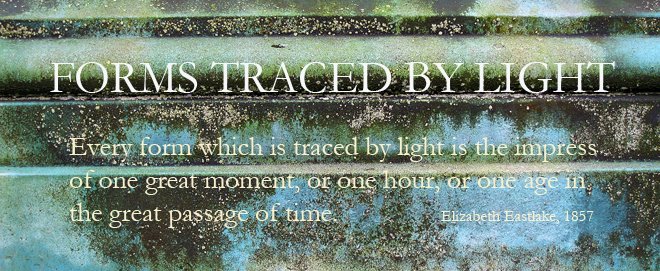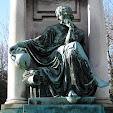Today, what was in many ways the main purpose of this trip - to see the "cross-pollination" exhibition which is currently on display at two sites: Thomas Cole's studio/family house in Catskill, and across the river, near the little town of Hudson, Frederic Church's huge, Moorish, hill-top residence and studio - well, one of them - Olana. But first, a meditative moment by the Olana lake: I sat there on a little landing stage for a while. And because I had my real camera - i.e. not my cell phone - with me for taking photos of the installations, this image has some real depth. This may be my favorite photo that I've taken this year ...
But what I'd really come for was stuff like this: a perfect gazebo in front of Cole's house, designed by Mark Dion and Dana Sherwood to hold hummingbird feeders - apparently the hummingbirds came all summer - and they were an homage to Martin Johnson Heade's paintings of iridescent hummingbirds. The whole of "Cross Pollination" shows twenty-first century art speaking back to the C19th in order to make us think about environmental issues - which of course is exactly what I'm writing a book about.
In front of the gazebo is a piece by Paula Hayes, Bird Nesting House and Tree (2013) which is designed (with an ornithologist) to provide a safe nesting place for bluebirds (though alas I can't see how it would deter sparrows) - there were a number of her terrariums, too, in both houses.
And this is a Nick Cage piece, Chaplet (2020), made of metal flowers - against Cole's wallpaper - for him, both representing life, but dispossession and injustice (there was one of his stunning sequined, beaded Soundsuit pieces in Olana, in prime position, framed at the end of the long hallway as one entered - part costume, part sculpture - one of many versions that he constructed in response to the Rodney King beatings).
And here, at Olana, is something I'll be speaking about at CAA in February: Jean Shin's Fallen, which was everything I'd hoped for ... a dead hemlock tree, one that Church himself had planted; a hemlock tree that was murdered, one might say, by the woolly adelgid beetle that's savaging hemlock trees all up the east coast. Hemlock trees were, of course, cut down in vast quantities in this area in the C19th (as Cole not only lamented but shows, say, in The Oxbow) and their bark used in the tanning industry - so Shin covered the dead tree trunk with leather, and studs, just like one might find on saddlery.
The stumps of branches that stick up from the sculpture look, on occasion, uncomfortably like human necks - something reinforced by the serendipitous insect positioned rather like a brooch.
And then throughout Olana's grounds, hemlocks - live and dead - are being tagged with labels that Shin designed - this means that going for a walk was very like a treasure hunt.
There were other things in the grounds, too - especially the huge banners made by Portia Munson - this is Sharp-Shinned Hawk (2017) - part of her Memento Mori Mandalas series, in which she uses a scanner both to record dead birds that she's found on her walks in the region (she's based in Catskill), and flowers that are blooming at the time - a record of transience.
And then, of course, there's Olana itself - I would love to set as a graduate exercise a comparative discussion of the Orientalism here, and that of Leighton House - indeed, there's probably a book, there ...
and for about five minutes, I could believe from the terrace that there are, actually, mountains out there;
and yet more Cross-Pollination pieces inside: this is a work (Tazetta Narcissus, 2014) by Flora Mace: she captures flowers, for ever, in molten glass: a little more complex than pressing flowers - but here they are, suspended in translucence - and through them, the books of Church's library.
There are so many more images from today ... it was unbelievably rich.














No comments:
Post a Comment